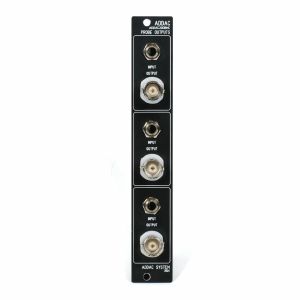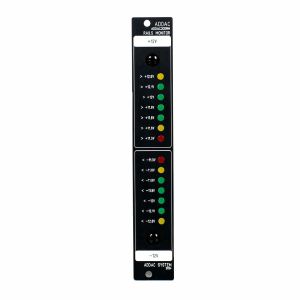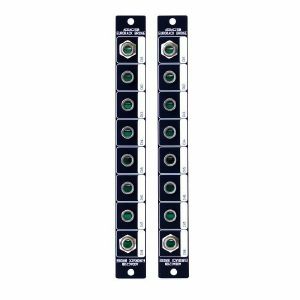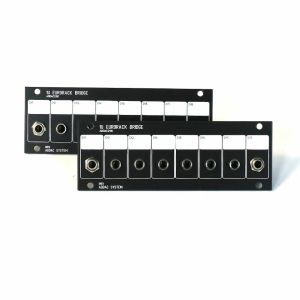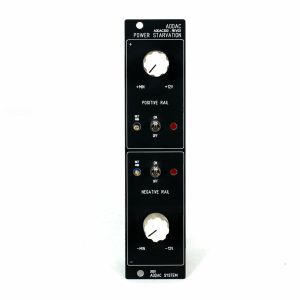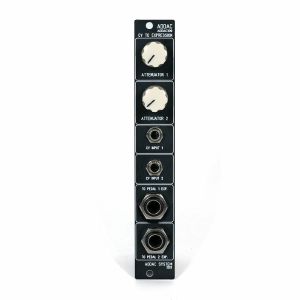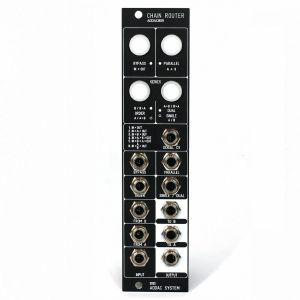Receive new release alerts for ADDAC System
Filter
Equipment
Format
Price
Items 1 to 9 of 9 on page 1 of 1
ADDAC System ADDAC200BNC Probe Outputs Module (modular synthesiser)
Cat: 1031331 Rel: 13 Sep 24
Probe outputs module - 4HP
Notes: A passive module to allow easy connection from Modular to Eurorack, avoid flimsy hook probes or alligator wires with a robust connection that will keep your signal intact.
Features:
3.5mm jack to BNC including 50O male-male cables.
Ships calibrated set to 10x as default, user's can select 1x but soldering a smd jumper.
Specs:
4HP
15mm deep
Passive
… Read moreFeatures:
3.5mm jack to BNC including 50O male-male cables.
Ships calibrated set to 10x as default, user's can select 1x but soldering a smd jumper.
Specs:
4HP
15mm deep
Passive
3 in stock $107.32
Click for better price!
or call +44 20 7424 1960
quote 1031331
quote 1031331
ADDAC System ADDAC200PI Dual Pedal Integrator Module (dual/stereo/external synth module)
Cat: 776156 Rel: 09 Sep 20
Pedal integrator module
Notes: This small utility is the pedal's lover best friend, it allows 2 diferent chains of pedals to be independently connected to your synth.
The Send channels attenuate the synth level to instrument level.
The Return channels amplify the signal from instrument to synth level.
Specs:
- Width: 4 HP
- Depth: 3 cm
- Max current: 10mA
… Read moreThe Send channels attenuate the synth level to instrument level.
The Return channels amplify the signal from instrument to synth level.
Specs:
- Width: 4 HP
- Depth: 3 cm
- Max current: 10mA
3 in stock $110.64
Click for better price!
or call +44 20 7424 1960
quote 776156
quote 776156
ADDAC System ADDAC200RM Rails Monitor Module (modular synthesiser)
Cat: 1028712 Rel: 13 Sep 24
LED voltage meter module - 4HP
Notes: ADDAC200RM allows a simple and straight forward way to monitor the voltage of your system. A 0.1% precision analogue voltage meter shows the status of both +12V and -12V rail.
Eurorack +/-12V power rails
Although we all refer to Eurorack PSU voltages as +12V and -12V this is hardly ever the case, although most systems operate at close proximity to this ideal reference, there are situations where the drop from the ideal voltage is large enough to influence the performance of your system.
PSU current ratings
Running a PSU too close to its limits will always cause more stress to the PSU, a good practice it to use only about 75% of your PSU maximum ratings, this will greatly extend the PSU life.
PSUs will show a small voltage drop as current increases which will drastically increase when pushed closed to it's limits. Heat will also influence this drop, heat is related to the current drawn, as more current is being drawn more heat will build up on the PSU, heat conditions will reduce the maxi- mum amount of current that can be delivered by the PSU. While the current consumption drop is somewhat stable and immediate (as you turn the frame on the current consumption will stabilize in a few seconds) the heat drop will take some time to occur, heat will build up over time until it stabilizes and only if it has "headroom" to stabilize. If heat dissipation is not effective than the drop will continue until it reaches a balance point which can be several volts below the 12V reference. At this point your PSU will be under great stress and the heat generated is prone to leave some permanent scars.
Heat will start to have an impact at about an ambient temperature of 50 degrees celsius, at 70 degrees the maxi- mum current rating will drop by 50%. If your PSU is rated at 2A maximum and it's running at 70 degrees then it will only be able to deliver 1A maximum.
For the PSU this is a complex balancing act as current influences heat and heat influences the maximum amount of current available which all together influences the voltage drop.
This is why it's so important to keep the PSU load at a sensible level.
PSU protections
Some PSUs feature over voltage, over current and overheating protection and will turn off when the operating conditions trigger any of the protection threshold levels.
At this point it's typical that the PSU will enter a Hiccup mode, where it turns on checks the current conditions and quickly turns off if they haven't changed, leaving it in an intermittent limbo where it powers on and off at some regular frequency.
If the conditions change enough to drop below the protection threshold levels then the PSU will automatically recover and stay on.
PSU stress
Different situations can be responsible for causing stress that can damage the PSU, it's possible to reverse a ribbon power cable enough times or leaving it connected long enough to partly damage the PSU.
Another situation is having a module that due to some partial previous damage may be drawing more current than specified which will not be accounted for when calculating your system current consumption.
Stress can cause permanent damage to the PSU, however some damages can be only partial leaving you with a PSU that no longer features the specs described by the manufacturer but with no apparent misbehaviour. The LED monitors on bus boards will be on, but in reality it will be underperforming at an unknown percentage of the original specs. These situations can be quite hard to debug without the proper tools to evaluate the cause of the problem.
PSU impact on modules
Some modules are more susceptible to PSU changes than others, modules that feature internal regulators will be less susceptible to PSU voltage, modules that use internal +5v, +/-9v, +/-10v regulators will have more tolerance than modules that use the PSU voltages directly like it is for most cases. Also modules that use voltage reverse protection will already have a 0.3v to 0.8v drop inherent to the protection circuit.
While many digital modules can withstand lower voltages some others will be more dependent on the reference voltage and may show strange behaviours.
This module can help preventing all these situations, it won't fix any problem but can help on the day-to-day monitoring of your system and in keeping your PSU in healthy conditions.
Tech Specs: 4HP/3,5 cm deep
60mA +12V
60mA -12V
… Read moreEurorack +/-12V power rails
Although we all refer to Eurorack PSU voltages as +12V and -12V this is hardly ever the case, although most systems operate at close proximity to this ideal reference, there are situations where the drop from the ideal voltage is large enough to influence the performance of your system.
PSU current ratings
Running a PSU too close to its limits will always cause more stress to the PSU, a good practice it to use only about 75% of your PSU maximum ratings, this will greatly extend the PSU life.
PSUs will show a small voltage drop as current increases which will drastically increase when pushed closed to it's limits. Heat will also influence this drop, heat is related to the current drawn, as more current is being drawn more heat will build up on the PSU, heat conditions will reduce the maxi- mum amount of current that can be delivered by the PSU. While the current consumption drop is somewhat stable and immediate (as you turn the frame on the current consumption will stabilize in a few seconds) the heat drop will take some time to occur, heat will build up over time until it stabilizes and only if it has "headroom" to stabilize. If heat dissipation is not effective than the drop will continue until it reaches a balance point which can be several volts below the 12V reference. At this point your PSU will be under great stress and the heat generated is prone to leave some permanent scars.
Heat will start to have an impact at about an ambient temperature of 50 degrees celsius, at 70 degrees the maxi- mum current rating will drop by 50%. If your PSU is rated at 2A maximum and it's running at 70 degrees then it will only be able to deliver 1A maximum.
For the PSU this is a complex balancing act as current influences heat and heat influences the maximum amount of current available which all together influences the voltage drop.
This is why it's so important to keep the PSU load at a sensible level.
PSU protections
Some PSUs feature over voltage, over current and overheating protection and will turn off when the operating conditions trigger any of the protection threshold levels.
At this point it's typical that the PSU will enter a Hiccup mode, where it turns on checks the current conditions and quickly turns off if they haven't changed, leaving it in an intermittent limbo where it powers on and off at some regular frequency.
If the conditions change enough to drop below the protection threshold levels then the PSU will automatically recover and stay on.
PSU stress
Different situations can be responsible for causing stress that can damage the PSU, it's possible to reverse a ribbon power cable enough times or leaving it connected long enough to partly damage the PSU.
Another situation is having a module that due to some partial previous damage may be drawing more current than specified which will not be accounted for when calculating your system current consumption.
Stress can cause permanent damage to the PSU, however some damages can be only partial leaving you with a PSU that no longer features the specs described by the manufacturer but with no apparent misbehaviour. The LED monitors on bus boards will be on, but in reality it will be underperforming at an unknown percentage of the original specs. These situations can be quite hard to debug without the proper tools to evaluate the cause of the problem.
PSU impact on modules
Some modules are more susceptible to PSU changes than others, modules that feature internal regulators will be less susceptible to PSU voltage, modules that use internal +5v, +/-9v, +/-10v regulators will have more tolerance than modules that use the PSU voltages directly like it is for most cases. Also modules that use voltage reverse protection will already have a 0.3v to 0.8v drop inherent to the protection circuit.
While many digital modules can withstand lower voltages some others will be more dependent on the reference voltage and may show strange behaviours.
This module can help preventing all these situations, it won't fix any problem but can help on the day-to-day monitoring of your system and in keeping your PSU in healthy conditions.
Tech Specs: 4HP/3,5 cm deep
60mA +12V
60mA -12V
1 in stock $119.48
Click for better price!
or call +44 20 7424 1960
quote 1028712
quote 1028712
ADDAC System ADDAC213B Modular Synthesiser Bridge Module (multiple/utility synth module)
Cat: 776251 Rel: 08 Sep 20
Bridge module
Notes: The ADDAC213B is the second pair of modules from ADDAC's Eurorack Bridge system.
A pair of ADDAC213Bs can be used in standalone to send/receive 8 CV or audio signals between different points inside the same case or as an expansion to the main pair of Eurorack Bridge modules, the ADDAC213As.
Two ADDAC213B modules can be connected to each other with the use of a single ribbon cable and then used inside a case to carry signals between distant points without the need for long cables. Less clatter, less spaghetti- more space of your fingers on those knobs!
ADDAC213Bs always come in pairs. A single pair can send & receive up to 8 CV or audio signals between different points in your case at the same time. The modules can be installed in normal position or a 180 degree position to fit any need.
As an Expansion to an ADDAC213A.
Each ADDAC213B connected to the backside of an ADDAC213A adds 8 more channels to the main bridging functionality of the ADDAC213A.
Up to 2 ADDAC213B can be connected to an ADDAC213A module, expanding the bridging between two difference cases to a total of 24 channels.
If you're looking for a simple one-cable bridge between your various cases, then look no further than the ADDAC213A.
Between the ADDAC213A pair and the ADDAC213B, your cases never looked so elegantly connected together!
Each module can be installed in normal position or at 180 degrees.
Comes with a 50cm ribbon cable. Custom sizes are available upon request.
Mechanical:
. Format: Eurorack
. Width: 3 HP
. Depth: 2.5 cm
Electrical:
Passive / Does not draw current
Ribbon Cable: 50cm or 100cm ribbon cable
… Read moreA pair of ADDAC213Bs can be used in standalone to send/receive 8 CV or audio signals between different points inside the same case or as an expansion to the main pair of Eurorack Bridge modules, the ADDAC213As.
Two ADDAC213B modules can be connected to each other with the use of a single ribbon cable and then used inside a case to carry signals between distant points without the need for long cables. Less clatter, less spaghetti- more space of your fingers on those knobs!
ADDAC213Bs always come in pairs. A single pair can send & receive up to 8 CV or audio signals between different points in your case at the same time. The modules can be installed in normal position or a 180 degree position to fit any need.
As an Expansion to an ADDAC213A.
Each ADDAC213B connected to the backside of an ADDAC213A adds 8 more channels to the main bridging functionality of the ADDAC213A.
Up to 2 ADDAC213B can be connected to an ADDAC213A module, expanding the bridging between two difference cases to a total of 24 channels.
If you're looking for a simple one-cable bridge between your various cases, then look no further than the ADDAC213A.
Between the ADDAC213A pair and the ADDAC213B, your cases never looked so elegantly connected together!
Each module can be installed in normal position or at 180 degrees.
Comes with a 50cm ribbon cable. Custom sizes are available upon request.
Mechanical:
. Format: Eurorack
. Width: 3 HP
. Depth: 2.5 cm
Electrical:
Passive / Does not draw current
Ribbon Cable: 50cm or 100cm ribbon cable
1 in stock $91.84
ADDAC System ADDAC213C 1U Eurorack Bridge Modules (pair) (utility synth module)
Cat: 944228 Rel: 14 Sep 23
An 1U utility module in 22HP.
Notes: A pair of ADDAC213Cs can be used in standalone to send/receive 8 CV or audio signals between different points inside the same case or as an expansion to the main pair of Eurorack Bridge modules, the ADDAC213As.
Standalone use:
Two ADDAC213C modules can be connected to each other with the use of a single ribbon cable and then used inside a case to carry signals between distant points without the need for long cables. Less clutter, less spaghetti, more space of your fingers on those knobs!
ADDAC213Cs always come in pairs. A single pair can send & receive up to 8 CV or audio signals between different points in your case at the same time.
Do you have modules that you often use together in different areas of your case? Would you prefer that each row's cables don't mingle with cables from other rows? Grab yourself a pair of ADDAC213s.
As an Expansion to an ADDAC213A:
Each ADDAC213C connected to the backside of an ADDAC213A adds 8 more channels to the main bridging functionality of the ADDAC213A.
Up to 2 ADDAC213C can be connected to an ADDAC213A module, expanding the bridging between two difference cases to a total of 24 channels.
If you're looking for a simple one-cable bridge between your various cases, then look no further than the ADDAC213A.
Between the ADDAC213A pair and the ADDAC213B, your cases never looked so elegantly connected together!
Check ADDAC213A for more information:
https://www.addacsystem.com/en/products/modules/addac200-series/addac213a
Price is for a pair of modules (2 modules) including two 50cm ribbon cables, only one is used to connect the two ADDAC213C together but two are necessary when connecting the two ADDAC213C to two ADDAC213A.
Comes with a 50cm ribbon cable. Custom sizes are available upon request.
Mechanical:
. Format: 1U Eurorack
. Width: 22HP
. Depth: 2.5 cm
Electrical:
Passive / Does not draw current
Ribbon Cable: 50cm or 100cm ribbon cable (custom sizes available upon request)
… Read moreStandalone use:
Two ADDAC213C modules can be connected to each other with the use of a single ribbon cable and then used inside a case to carry signals between distant points without the need for long cables. Less clutter, less spaghetti, more space of your fingers on those knobs!
ADDAC213Cs always come in pairs. A single pair can send & receive up to 8 CV or audio signals between different points in your case at the same time.
Do you have modules that you often use together in different areas of your case? Would you prefer that each row's cables don't mingle with cables from other rows? Grab yourself a pair of ADDAC213s.
As an Expansion to an ADDAC213A:
Each ADDAC213C connected to the backside of an ADDAC213A adds 8 more channels to the main bridging functionality of the ADDAC213A.
Up to 2 ADDAC213C can be connected to an ADDAC213A module, expanding the bridging between two difference cases to a total of 24 channels.
If you're looking for a simple one-cable bridge between your various cases, then look no further than the ADDAC213A.
Between the ADDAC213A pair and the ADDAC213B, your cases never looked so elegantly connected together!
Check ADDAC213A for more information:
https://www.addacsystem.com/en/products/modules/addac200-series/addac213a
Price is for a pair of modules (2 modules) including two 50cm ribbon cables, only one is used to connect the two ADDAC213C together but two are necessary when connecting the two ADDAC213C to two ADDAC213A.
Comes with a 50cm ribbon cable. Custom sizes are available upon request.
Mechanical:
. Format: 1U Eurorack
. Width: 22HP
. Depth: 2.5 cm
Electrical:
Passive / Does not draw current
Ribbon Cable: 50cm or 100cm ribbon cable (custom sizes available upon request)
3 in stock $87.40
ADDAC System ADDAC300 REV.02 Power Starvation Module (effect synth module)
Cat: 1075525
A revision 02 of ADDAC's Power Starvation module
Notes: This is a revision 02 of ADDAC's Power Starvation module.
It provides an "ideal" way to power starve other modules, starving modules means the modules will receive less voltage than the standard +/-12V supply.
Power starvation is the first hack that any "DIY'er" learns. It's also one of the hacks that can generate some of the most interesting sonic effects in circuit bending.
Plug any module below +/-200mA through it and independently tune it's supply power. This will have most interesting effects in analog modules: filters, delays, mixers... They can either go silent or start screaming at your ears, going berserk with the lack of current to behaving normally, making them cough, choke... Something like a safely induced heart attack...
While revision 01 was a simple circuit with pot working as a voltage divider, this upgraded version uses a DC to DC converter that receives its input from the +12V power rail and outputs a bipolar 15V supply. This DC-DC converter also offers short circuit and overcurrent protection. The +/-15V lines are then sent through variable analog voltage regulators that can output a range of 2.5V to 13.5V.
In other words, the module features a +/-200mA PSU with variable voltage outputs.
Safety disclaimer:
While using ADDAC300 should be safe for any module, there may be specific modules where its use may not be advised.
!! Use at your own risk !!
ADDAC System won't be responsible for any issue that may arise while using ADDAC300 power starvation.
If in doubt contact ADDAC prior to any connection.
Tech Specs:
6HP
4.5cm deep
UP TO 600mA +12V (Depending on the starving module connected)
0mA -12V
… Read moreIt provides an "ideal" way to power starve other modules, starving modules means the modules will receive less voltage than the standard +/-12V supply.
Power starvation is the first hack that any "DIY'er" learns. It's also one of the hacks that can generate some of the most interesting sonic effects in circuit bending.
Plug any module below +/-200mA through it and independently tune it's supply power. This will have most interesting effects in analog modules: filters, delays, mixers... They can either go silent or start screaming at your ears, going berserk with the lack of current to behaving normally, making them cough, choke... Something like a safely induced heart attack...
While revision 01 was a simple circuit with pot working as a voltage divider, this upgraded version uses a DC to DC converter that receives its input from the +12V power rail and outputs a bipolar 15V supply. This DC-DC converter also offers short circuit and overcurrent protection. The +/-15V lines are then sent through variable analog voltage regulators that can output a range of 2.5V to 13.5V.
In other words, the module features a +/-200mA PSU with variable voltage outputs.
Safety disclaimer:
While using ADDAC300 should be safe for any module, there may be specific modules where its use may not be advised.
!! Use at your own risk !!
ADDAC System won't be responsible for any issue that may arise while using ADDAC300 power starvation.
If in doubt contact ADDAC prior to any connection.
Tech Specs:
6HP
4.5cm deep
UP TO 600mA +12V (Depending on the starving module connected)
0mA -12V
Pre-orders at Juno
This product is available for pre-order at Juno, for shipping on the release date. You won’t be charged until the order is despatched.
We'll keep you informed of your order at every stage, and let you know if the release date changes.
If the price of the item drops before it's released, you will pay the lower price, but if it increases, you'll only pay the price you see today.
If you also include in-stock items on your order, they’ll be charged and shipped within 24 hours as usual.coming soon $142.73
(No payment required now - pay when released)
ADDAC System ADDAC309 CV To Expression Module (attenuator/controller/CV modulation/effect/expression/external/utility module)
Cat: 992144 Rel: 26 Apr 24
CV to expression module - 4HP
Notes: Take up to two CV signals and this passive module converts them to TRS outputs in order to control effects pedal modulation inputs, with attenuation on both channels. Simple, straightforward stuff.
Supplier's Notes:
ADDAC309 CV to Expression allows a simple and straight forward connection between modular and effect pedals that features expression pedal TRS inputs.
Instead of using an expression pedal into the effects pedal the user can use this module in between a CV source and the Effects pedal to be controlled.
This is a great way to control the available parameters on the effects pedals straight from a CV source.
ADDAC309 features 2 channels each with a CV Input with attenuator and a 1/4" jack output.
This is a passive module, the power needed for operation is taken from the pedal power instead of the modular frame, this allows for perfect matching of the pedal's operating voltage which can range from 3.3v to 9v.
Tech Specs:
4HP
3,5cm deep
Passive module
… Read moreSupplier's Notes:
ADDAC309 CV to Expression allows a simple and straight forward connection between modular and effect pedals that features expression pedal TRS inputs.
Instead of using an expression pedal into the effects pedal the user can use this module in between a CV source and the Effects pedal to be controlled.
This is a great way to control the available parameters on the effects pedals straight from a CV source.
ADDAC309 features 2 channels each with a CV Input with attenuator and a 1/4" jack output.
This is a passive module, the power needed for operation is taken from the pedal power instead of the modular frame, this allows for perfect matching of the pedal's operating voltage which can range from 3.3v to 9v.
Tech Specs:
4HP
3,5cm deep
Passive module
1 in stock $80.76
Click for better price!
or call +44 20 7424 1960
quote 992144
quote 992144
ADDAC System ADDAC711 Balanced Inputs Module (dual/stereo/external synth module)
Cat: 904678 Rel: 19 Jan 23
ADDAC711 is a dual channel Isolated DI box and is all about keeping the sound coming into your Modular free from any undesired noisy interferences, making sure that what you’re getting from your inputs is what your external hardware is actually producing.
Notes: ADDAC711 is a dual channel Isolated DI box and is all about keeping the sound coming into your Modular free from any undesired noisy interferences, making sure that what you're getting from your inputs is what your external hardware is actually producing. It provides galvanic electrical isolation between the Modular system and external sources preventing impedance mismatch and ground loop induced hum. ADDAC's 711 circuit is designed around a unity 1:1 type Low-cost Audio Transformer operating in the 20 Hz to 20 KHz range, this impedance matching transformer provides two fully balanced outputs (via XLR connectors).
There are two independent channels on the module with:
Audio Output
Signal overload warning led
LIFT/FLOAT/GND toggle switch
Gain control
XLR Input
The LIFT/FLOAT/GND 3-way switch lets you choose between lift, ground or floating ground. In the LIFT position (left) the module circuit will be "lifted" to ground through a 100R resistor and a 10nF capacitor. In the FLOAT position (middle) Ground will not be shared leaving ins and outs grounds completely apart from each other fully isolating both signals.
In the GND position Ground will be shared between inputs and outputs, here no isolation is used. Any of these three positions may be the best form of avoiding ground loops or any other undesired interference occurring between your modular and the external hardware. Try out which one of these options will work best in any given situation.
The importance of using Audio Transformers
Applying a transformer balanced input isolation has lots of advantages over other less expensive ways for dealing with ground loop issues. This method provides the chance to set a very simple and cleancircuit in which the signal transfer process develops smoothly and humming free. The transformer is a device that performs both signal balancing and high-to-low (or vice-versa) impedance conversion, while rejecting straggled DC voltage and Radio Frequency Interference from signal passing through a magnetic bridge. In a transformer, two (or more) coils (called windings) of insulated wire wound around a magnetic metal core allow for its input(s) and output(s) not to be physically connected together. When an AC signal passes through the input winding (the primary), a perfectly related AC signal appears on the output winding (the secondary). This way, by the fact that signal flows via inductive coupling between the two windings of the transformer, this module presents a most accurate electrical isolation between its input and output. A same number of windings on each coil guarantees that there's no gain loss when audio signal passes from the primary to the secondary windings. Furthermore, since these two windings are insulated from each other, the transformer will electrically isolate ADDAC711 from any other device, preventing hum problems coming from an outsider ground. Being a low-cost transformer the frequency response curve is not completely linear, still the -0.2dB
attenuation at 50Hz feels negligible.
… Read moreThere are two independent channels on the module with:
Audio Output
Signal overload warning led
LIFT/FLOAT/GND toggle switch
Gain control
XLR Input
The LIFT/FLOAT/GND 3-way switch lets you choose between lift, ground or floating ground. In the LIFT position (left) the module circuit will be "lifted" to ground through a 100R resistor and a 10nF capacitor. In the FLOAT position (middle) Ground will not be shared leaving ins and outs grounds completely apart from each other fully isolating both signals.
In the GND position Ground will be shared between inputs and outputs, here no isolation is used. Any of these three positions may be the best form of avoiding ground loops or any other undesired interference occurring between your modular and the external hardware. Try out which one of these options will work best in any given situation.
The importance of using Audio Transformers
Applying a transformer balanced input isolation has lots of advantages over other less expensive ways for dealing with ground loop issues. This method provides the chance to set a very simple and cleancircuit in which the signal transfer process develops smoothly and humming free. The transformer is a device that performs both signal balancing and high-to-low (or vice-versa) impedance conversion, while rejecting straggled DC voltage and Radio Frequency Interference from signal passing through a magnetic bridge. In a transformer, two (or more) coils (called windings) of insulated wire wound around a magnetic metal core allow for its input(s) and output(s) not to be physically connected together. When an AC signal passes through the input winding (the primary), a perfectly related AC signal appears on the output winding (the secondary). This way, by the fact that signal flows via inductive coupling between the two windings of the transformer, this module presents a most accurate electrical isolation between its input and output. A same number of windings on each coil guarantees that there's no gain loss when audio signal passes from the primary to the secondary windings. Furthermore, since these two windings are insulated from each other, the transformer will electrically isolate ADDAC711 from any other device, preventing hum problems coming from an outsider ground. Being a low-cost transformer the frequency response curve is not completely linear, still the -0.2dB
attenuation at 50Hz feels negligible.
1 in stock $232.33
ADDAC System ADDAC809 Chain Router Module (black) (switch/utility synth module)
Cat: 883866 Rel: 13 Oct 22
ADDAC809 is a dynamic CV operated I/O router that allows one source (Audio or CV) to be routed through 2 different chains (of one or more modules) before being sent to an output.
Notes: ADDAC809 is a dynamic CV operated I/O router that allows one source (Audio or CV) to be routed through 2 different chains (of one or more modules) before being sent to an output.
Six routing patterns are allowed:
1. IN > OUT
2. IN > CHAIN A > OUT
3. IN > CHAIN B > OUT
4. IN > CHAIN A > CHAIN B > OUT
5. IN > CHAIN B > CHAIN A > OUT
6. IN > > OUT
A practical example is to have an audio source, a delay and a looper.
And the question: should the delay be placed before or after the looper? Sometimes you may need the delay to be before the looper as you may want to sample the audio with the delay or sample the pure audio source and apply the delay afterwards.
This small utility module solves this issue on the fly without having to repatch anything.
INPUTS & OUTPUTS
TO CHAIN B: Connect to your Chain B input
FROM CHAIN B: Connect to your Chain B output
TO CHAIN A: Connect to your Chain A input
FROM CHAIN A: Connect to your Chain A output
INPUT: Connect to your Input Source
OUTPUT: Connect to your Output Source
ROUTING PATTERNS
There are 2 ways to address the six routing patterns:
Buttons: using the frontpanel push buttons and/or dedicated trigger inputs to latch between 2 states.
BYPASS: Chooses between Pattern 1 and any other pattern
PARALLEL: Chooses between Pattern 6 and any other pattern
ORDER: Chooses the order A before B or B before A
DUAL/SINGLE: Chooses to use a Dual (A>B or B>A) or Single chain (A or B)
CV: The dedicated CV input expects a 0 to +5v input and allows to jump to the precise routing pattern using a specific voltage interval in increments of approx. 0.83V:
Pattern 1: 0v to 0.83v
Pattern 2: 0.83v to 1.66v
Pattern 3: 1.66v to 2.5v
Pattern 4: 2.5v to 3.33V
Pattern 5: 3.33v to 4.16V
Pattern 6: 4.16v to 5V
Tech Specs:
Width: 12 HP
Depth: 55mm
Current: 80mA +12V / 30mA -12V
… Read moreSix routing patterns are allowed:
1. IN > OUT
2. IN > CHAIN A > OUT
3. IN > CHAIN B > OUT
4. IN > CHAIN A > CHAIN B > OUT
5. IN > CHAIN B > CHAIN A > OUT
6. IN > > OUT
A practical example is to have an audio source, a delay and a looper.
And the question: should the delay be placed before or after the looper? Sometimes you may need the delay to be before the looper as you may want to sample the audio with the delay or sample the pure audio source and apply the delay afterwards.
This small utility module solves this issue on the fly without having to repatch anything.
INPUTS & OUTPUTS
TO CHAIN B: Connect to your Chain B input
FROM CHAIN B: Connect to your Chain B output
TO CHAIN A: Connect to your Chain A input
FROM CHAIN A: Connect to your Chain A output
INPUT: Connect to your Input Source
OUTPUT: Connect to your Output Source
ROUTING PATTERNS
There are 2 ways to address the six routing patterns:
Buttons: using the frontpanel push buttons and/or dedicated trigger inputs to latch between 2 states.
BYPASS: Chooses between Pattern 1 and any other pattern
PARALLEL: Chooses between Pattern 6 and any other pattern
ORDER: Chooses the order A before B or B before A
DUAL/SINGLE: Chooses to use a Dual (A>B or B>A) or Single chain (A or B)
CV: The dedicated CV input expects a 0 to +5v input and allows to jump to the precise routing pattern using a specific voltage interval in increments of approx. 0.83V:
Pattern 1: 0v to 0.83v
Pattern 2: 0.83v to 1.66v
Pattern 3: 1.66v to 2.5v
Pattern 4: 2.5v to 3.33V
Pattern 5: 3.33v to 4.16V
Pattern 6: 4.16v to 5V
Tech Specs:
Width: 12 HP
Depth: 55mm
Current: 80mA +12V / 30mA -12V
2 in stock $116.82
Items 1 to 9 of 9 on page 1 of 1

 USD
USD





